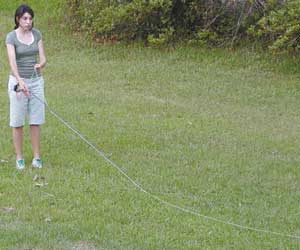
The last distance casting contest I attended was a shameless exhibition of male testosterone. With his arms and hips and shoulders spinning and gyrating, all one contestant needed was a pair of shades and a rhinestone suit, and you’d thought Elvis was in the building.
Another contestant had a simpler strategy. With each forward cast, he punched the rod out with brute force a la Bruce Lee, releasing a grunting sound.
What’s frightening is that some of these folks actually teach casting to others.
Perhaps they need to be informed that all that energy is waste. Today’s modern graphite fly rods are nearly capable of casting themselves. All you need do is provide them inertia.
Unlike casting or spinning rods, fly rods are constantly in control of the line. They respond immediately and precisely to every action the caster makes. Casting is what makes fly fishing a truly zen means to catch a fish. The downside is that it takes patience and lots of practice.
Effortless casting was a trait taught to me by the renown Doug Swisher some 15 years ago. Swisher’s techniques — the horizontal cast and the micro-second wrist — are in contrast to the widely accepted instructional style of the overhead cast and the “stiff wrist.”
Overhead casting is what we do most often, but it’s not the best way to learn. Besides getting a crick in the neck, the caster doesn’t have the advantage of viewing his arm movement and line movement in the same plane, or being able to inspect a straight line path.
Swisher’s techniques also aim to reduce body motion and keep the cast confined to the lower arm, where the caster has greater control. Once you’ve used Swisher’s techniques to master the control method, you’ll then be able to make precise overhead, sidearm or even cross-body casts with casual effort.
Before you ever put a rod in your hand, find something short that resembles a fly rod handle. Heck, even a stick will do. Also, get a poster board and draw the top half of a clock on the board. Using up the whole board helps.
To start, place the poster on the side you plan to cast. Grab your “practice handle” and hold it with the thumb extended on top. Lay your forearm out to the side 90 degrees, and turn it so the inner part of the arm is facing up.
The closed palm of your hand should face you. The thumb should be pointed away from you.
Cock your wrist forward, and start at the 9 o’clock position. Slowly swing the forearm back to the noon position, and stop it there, but simultaneously flick the wrist back so the handle/thumb are at the 1 o’clock postion.
This is critical: The micro-second wrist is a flick, just a slight movement. You’ll know you “broke the wrist” — a serious taboo — if the thumb/handle is extended perpendicular to the forearm.
For the forward cast, move the elbow forward a few inches, then swing the forearm to the 11 o’clock position, then flick the wrist to the 10 o’clock position.
Let me explain the physics here. With each cast, forward or backward, your motion starts with the elbow, then to the forearm, and finally to the wrist. Each progression has an increase in velocity. Essentially, you want to start slow and accelerate to a hard stop.
It’s also important that as your hand moves, it does so in a straight line. Also, your elbow should never be more than a few inches from your body.
When the whole motion becomes fluid, such that as one motion ends another has already begun, and the range of the handle stays entirely with the 10 o’clock to 1 o’clock boundaries, you are ready for the next step — actual casting.
Having a fluid, integrated acceleration of motion is critical to avoiding “tailing loops.” Believe me, you’ll know what these are when you see them.
Take your rod out to a grassy area that has a sidewalk or a parking lot. The concrete edge will serve as a straight line marker. Otherwise, bring a tape measure or piece of string, and use it.
Strip off about 20 feet of line outside the tip of the rod. Hold the forearm out horizontally as you did in the practice sessions. In turn, the rod will be horizontal to the ground.
After each forward cast and backcast, stop completely and examine if the line went out in a straight path. If not, then pay attention to your forearm and wrist while you cast to ensure your technique is correct.
Are you starting slowly and speeding to a fast stop? Are you maintaining a 10 o’clock to 1 o’clock arc with the rod? Is the hand — and consequently the rod tip — moving in a straight line?
After some time with proper technique, both the forward cast and backcast will land fairly straight every cast. At this point, begin the false casting stage. On the backcast, as soon as the line straightens out, start the forward cast. And vice versa.
After a while, this pace will quicken such that as the line barely kisses the grass, it’s back in motion the other way. At this point, given that your rod tip is traveling only a few feet off the ground, it’s safe to say you’ve mastered the false cast.
If you plan to fish from a canoe or kayak, or just have problems controlling your body movement when you cast, I advise sitting in a lawn chair or just on the grass, and practice casting from that position.


